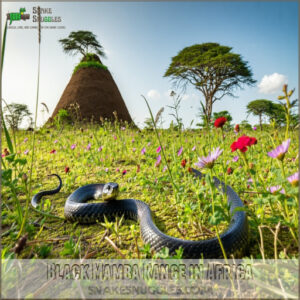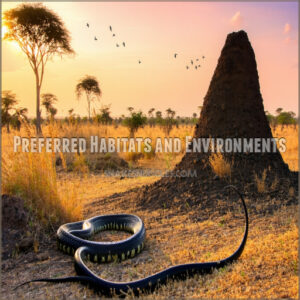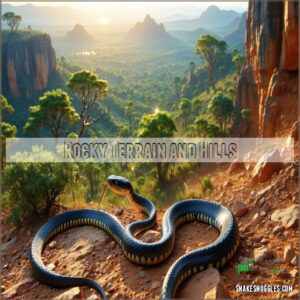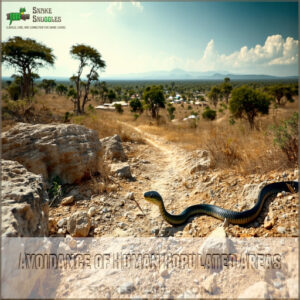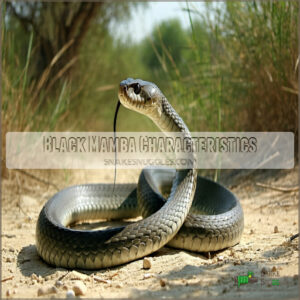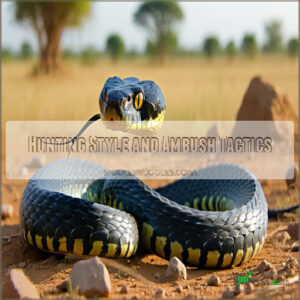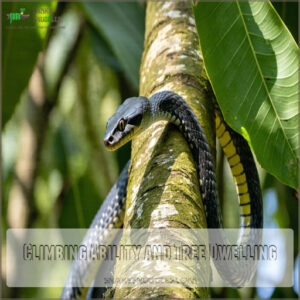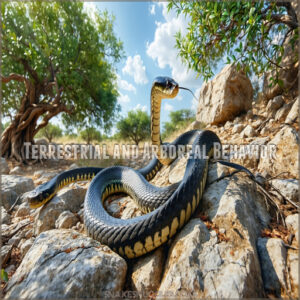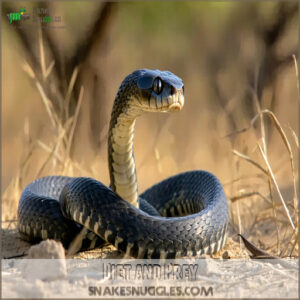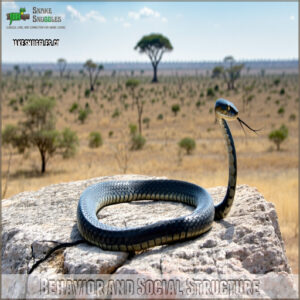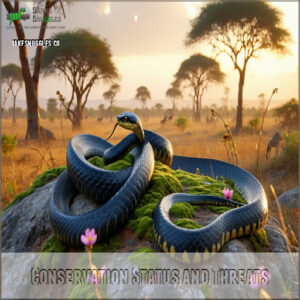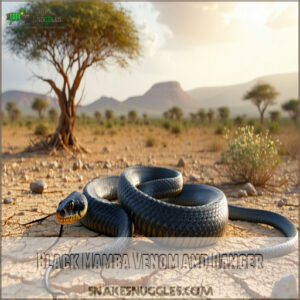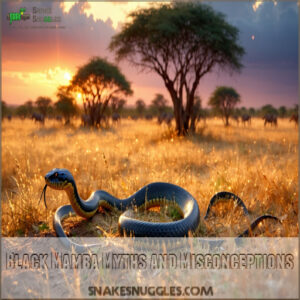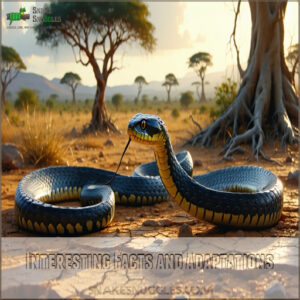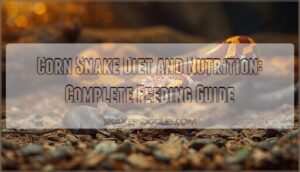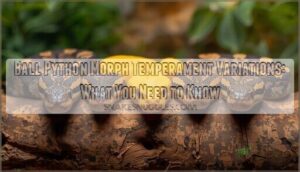This site is supported by our readers. We may earn a commission, at no cost to you, if you purchase through links.
 The black mamba’s range spans much of sub-Saharan Africa, from South Africa to Ethiopia and Senegal to Somalia.
The black mamba’s range spans much of sub-Saharan Africa, from South Africa to Ethiopia and Senegal to Somalia.
You’ll find these sleek, olive-gray beauties in savannas, woodlands, rocky hills, and lowland forests. They prefer cozy hideouts like termite mounds and tree hollows but steer clear of human-dominated areas (who can blame them?).
With their lightning-fast reflexes and venom that means business, they’re perfectly adapted to catch birds, bats, and small mammals. While they seem like a reptile straight out of a thriller, black mambas are more elusive than aggressive—just don’t step on one.
Curious about their speed? You won’t believe it, and it’s a testament to their reptile straight out of a thriller nature.
Table Of Contents
- Key Takeaways
- Black Mamba Range in Africa
- Habitat and Distribution
- Black Mamba Characteristics
- Speed and Movement
- Diet and Prey
- Behavior and Social Structure
- Conservation Status and Threats
- Black Mamba Venom and Danger
- Black Mamba Myths and Misconceptions
- Interesting Facts and Adaptations
- Frequently Asked Questions (FAQs)
- Where do black mamba snakes live?
- How fast can a black mamba go?
- How long is a black mamba snake?
- Where do black mamba fend for themselves?
- How many mamba species are there?
- Is a black mamba endangered?
- Where are black mambas found in Africa?
- Is a black mamba bite 100% fatal?
- Are black mambas in the USA?
- How many people are killed by black mambas?
- Conclusion
Key Takeaways
- You’ll find black mambas across sub-Saharan Africa, thriving in savannas, woodlands, rocky hills, and forests, avoiding urban areas.
- These snakes rely on habitats like termite mounds, tree hollows, and rocky crevices for shelter and survival.
- Their range includes countries like South Africa, Kenya, Tanzania, Angola, and Mozambique, highlighting their adaptability to diverse ecosystems.
- Black mambas avoid humans and prefer secluded, natural environments where they remain elusive and independent.
Black Mamba Range in Africa
You’ll find black mambas slithering across sub-Saharan Africa, from savannas and rocky hills to woodlands and shrublands.
They avoid crowded human areas and instead choose places like termite mounds or tree hollows as their homes.
Countries Where Black Mambas Are Found
Black mambas dominate the sub-Saharan African Range, thriving in countries like South Africa, Kenya, and Tanzania.
Their geographic spread extends to areas like Botswana and Mozambique, steering clear of urban chaos.
The black mamba habitat favors solitude over city streets, with their distribution map showcasing a love for wilderness and rocky outcrops.
These snakes prefer peace over people!
Black mambas are found in areas with suitable rocky savannas that provide them with the necessary shelter and hunting grounds.
Regions With Suitable Habitat
Imagine the elegance of a black mamba weaving through African landscapes. It thrives in areas rich with savanna ecosystems, woodland habitats, and rocky terrain of sub-Saharan regions.
From dry forests to rugged hills, its natural domain spans far and wide, rarely crossing paths with people.
- Shades of gold and green in open woodlands
- Scenic rocky terrain in southern Africa
- Remote mamba-friendly savannas
- Sanctuaries protecting wildlife
- Vast untouched wilderness
Types of Ecosystems Inhabited
Thriving across savannas, woodlands, grasslands, and rocky terrains, the black mamba showcases its amazing versatility.
From dry forests to rugged mountains and sheer cliffs, its perfect blend of speed and agility keeps it ahead of predators—well, most of them!
Balancing life between ground burrows and occasional tree-climbs, this lightning-fast snake adapts effortlessly to diverse African ecosystems, avoiding humans whenever possible.
Geographic Range and Distribution
You’ll find black mambas roaming the sub-Saharan regions, covering diverse areas like woodland habitats, rocky terrain, and vast savanna ecosystems.
Their geographic footprint includes many African countries such as South Africa, Angola, and Botswana.
Here’s a quick breakdown of their range:
- Sub-Saharan Africa
- Rocky terrain in eastern regions
- Savanna ecosystems
- Woodland habitats
- Countries with black mambas: South Africa, Namibia, Zimbabwe, and Mozambique
Black mambas thrive in various snake habitat types that offer suitable conditions for their survival in sub-Saharan Africa and other African countries.
Habitat and Distribution
You’ll find black mambas in sub-Saharan Africa, where they inhabit rocky savannas, woodlands, and lowland forests.
They prefer places with plenty of hiding spots like termite mounds, tree hollows, and rocky crevices, steering clear of human-populated areas whenever possible, which helps them thrive in their preferred lowland forests.
Preferred Habitats and Environments
You’ll often find African black mambas in secluded spots like rocky terrain, woodland habitats, and forest floors.
Their black mamba habitat includes everything from savanna ecosystems to grassland environments, avoiding human areas.
These nimble predators prefer termite mounds or tree cavities for refuge.
| Habitat Type | Features | Example Locations | Benefit to Mambas |
|---|---|---|---|
| Savanna Ecosystems | Open grasslands | Kenya, Tanzania | Space for quick movement |
| Rocky Terrain | Rugged outcrops | South Africa, Namibia | Perfect hiding spots |
| Woodland Habitats | Dense tree cover | Angola, Zambia | Hunting and nesting |
| Forest Floors | Leafy, shaded grounds | Cameroon, Gabon | Camouflage and shelter |
The African black mambas are found in various habitats, and their ability to thrive in these environments is due to their adaptability and hunting skills.
Types of Woodlands and Savannas
The African Black Mamba thrives in forest ecosystems and savanna grasslands, blending effortlessly into woodland habitats.
These regions provide shelter, food, and ideal hunting grounds. Diverse African landscapes, from grassy expanses to scattered tree zones, suit their needs.
- Food Sources: Small mammals and birds
- Hunting Zones: Grasslands and sparse woodlands
- Threats: Black mamba habitat loss, human expansion
- Conservation Needs: Protecting mamba range essentials
Rocky Terrain and Hills
In rugged terrains like rocky outcrops and hill habitats, black mambas showcase their incredible adaptability.
These sleek predators thrive in such environments thanks to:
- Rock crevices for hiding and resting
- Hilltop vantage points to scan for prey
- Steep cliffs aiding their agility
- Savanna landscapes blending for camouflage
This mastery of terrain guarantees their stealth across the black mamba geographical distribution.
Avoidance of Human Populated Areas
Black mambas are masters of spatial behavior, sticking to wild landscapes far from urban boundaries.
Their knack for habitat selection keeps them in rocky savannas, woodlands, and areas unspoiled by human activity.
This solitude-loving snake avoids conflict, blending effortlessly with nature while steering clear of bustling cities.
Curious about their range? A glance at the black mamba range map shows their geographical distribution thriving in South Africa and beyond—untouched by habitat loss.
Black Mamba Characteristics
You won’t find a black mamba that’s actually black—it’s more of an olive-gray with a lighter underside.
This long, slender snake, often reaching up to 14 feet, has a coffin-shaped head and smooth scales built for speed.
Physical Description and Color
A black mamba’s beauty lies in its subtle details.
Though its name sounds fearsome, this African snake species sports an olive-grey appearance with smooth, sleek scales.
Its body shape is slender and aerodynamic, topped with a coffin-shaped head.
Unique facts include:
- Its underside is lighter in color.
- The black inside of its mouth inspires its name.
- Its scale pattern reflects earthy tones.
The black mamba’s speed is influenced by its venom speed effects, which is a critical aspect of its behavior, and its overall venom composition plays a significant role.
Average Length and Weight
You’ll be amazed by their size.
With length variations from 8 to 14 feet, black mambas are true giants among African snake species.
On average, they weigh about 3.5 pounds.
Their lightweight build isn’t just for show—it’s a major factor behind their speed and agility.
These sleek hunters seem crafted for stealth, precision, and awe-inspiring movement.
Body Shape and Scales
Picture the black mamba as nature’s sleek athlete, built for speed and stealth.
Its body, elegantly streamlined, glides effortlessly. Scales tell the story—shiny, olive-grey armor that’s both durable and discreet.
Here’s why they matter:
- Scale Patterns: Blend seamlessly with rocks and foliage.
- Snake Texture: Smooth for effortless movement.
- Body Color: Subtle shades, from olive hue to grey scales.
Unique Features and Adaptations
Think of a ninja with ultimate stealth.
Camouflage skills help the black mamba blend seamlessly into its habitat, while scale patterns enhance its agility.
Its venom delivery system is fearsome, paralyzing prey in seconds.
Heat sensing detects faint movements, making escape nearly impossible.
Add to that lightning-fast speed and you’ve got a predator built for survival and domination.
Speed and Movement
You’d be amazed at how quickly a black mamba can move, reaching speeds of up to 12 miles per hour.
This incredible agility helps it escape threats and chase down prey with remarkable efficiency.
Speed and Agility
Built like a sleek sports car, the black mamba’s movement speed reaches 12 mph—one of the fastest snakes.
Its agility and quick reflexes make it a master of escape and predation.
Key attributes include:
- Slim, aerodynamic body for speed.
- Powerful muscles, perfect for bursts.
- S-shaped serpentine motion, ensuring efficiency.
- Exceptional coordination, ideal for quick strikes.
The black mamba’s venom potency and snake attack behaviors make it a formidable predator in its native habitat.
Hunting Style and Ambush Tactics
Mastering stealth movement, black mamba hunting strategies rely on precision and speed.
They creep close, then strike with venom delivery so rapid, prey barely reacts.
These ambush tactics highlight their agility, as they inject venom and wait for it to take effect.
This lethal combination of black mamba behavior and speed underscores their unmatched prey capture skills and terrifying efficiency.
Climbing Ability and Tree Dwelling
The black mamba’s tree climbing is impressive, combining agility and speed.
It scales trunks effortlessly, using strong muscles and sharp focus to explore the forest canopy.
In habitats like mango trees or termite mounds, it balances along branches while hunting or finding tree hollows for shelter.
Leaf cover provides camouflage, letting this arboreal snake remain undetected in its environment, ready to strike with sharp focus.
Terrestrial and Arboreal Behavior
Moving effortlessly between ground movement and tree climbing, the black mamba thrives across its habitat.
Whether slithering through savannah life or forest dwelling, this arboreal and terrestrial snake masters stealth.
It stalks prey along rocky terrains or among branches, always alert to threats.
- Lightning-like speeds on land
- Expert maneuvering in rock habitat or trees
- Adaptable in diverse environments on the black mamba range map
Diet and Prey
You might be surprised by how varied a black mamba’s diet is.
From small mammals like hyraxes to birds and bats, these snakes use their speed, venom, and keen senses to make quick work of their prey.
Types of Prey and Hunting Strategy
You’ve got to admire the black mamba’s hunting style—it’s all about patience and precision.
Instead of chasing prey, it relies on Ambush Strategies, waiting silently for the perfect moment.
With lightning-fast Venom Delivery, it paralyzes birds or small mammals instantly.
These efficient Hunting Tactics reflect its role in African Wildlife Conservation as one of the top Snake Species Africa offers.
Favorite Food Sources and Hunting Grounds
Stalking prey with precision, black mambas rely on their speed, venom, and ambush tactics to catch small mammals and birds.
Preferred black mamba food sources include hyraxes and rodents, often found in rocky hills, low woodlands, or termite mounds.
These sneaky predators blend perfectly with their habitat, striking swiftly and efficiently, reflecting a keen adaptation to Africa’s vast and diverse wildlife food chains with their speed.
Feeding Habits and Consumption Patterns
Regarding feeding, black mambas waste no time.
Their prey selection includes birds and small mammals, which they catch using swift hunting tactics. They strike precisely, delivering venom that quickly incapacitates prey.
Their feeding behavior is fascinating—these African reptiles can swallow meals larger than their heads, thanks to their flexible jaws.
- Key Facts:
- Efficient digestion supports their high consumption rates.
- Prey is eaten whole.
- Meals last for days.
Importance of Hyraxes and Small Mammals
Hyraxes and small mammals are the “fast food” of the black mamba world.
These tiny creatures shape the snake’s prey selection and hunting tactics, creating balance in the African food chain.
- Hyrax Diet: Hyraxes are a staple in mamba meals.
- Rodent Patrol: Mambas limit rodent overpopulation.
- Ecosystem Role: Their appetite helps counter black mamba habitat loss impacts.
Behavior and Social Structure
You’ll find that black mambas are mostly loners, sticking to themselves unless it’s breeding season.
These snakes are highly territorial, yet their nervous nature often drives them to avoid conflict when possible.
Diurnal Behavior and Activity Patterns
Black mambas stick to daylight for action.
You’ll find them basking in the morning, soaking up warmth like a reptilian sunbather. Once energized, they hunt small creatures during the day, moving swiftly through their range.
By afternoon, it’s all about resting and conserving energy. Late afternoon might involve scouting nest sites, avoiding nocturnal activity entirely.
It’s survival, day-by-day, in their diverse habitats.
Solitary Animals and Territoriality
In the calm mornings, black mambas stake out their territories with precision.
These snakes thrive in solitary behavior, fiercely guarding their animal boundaries when necessary.
Most times, they’d escape conflict, but if resources are low, they’re ready to defend their space.
- Space defense: black mambas avoid unnecessary fights but will confront intruders in overlapping habitats.
- Preferred habitats curb social isolation unless food and mates are scarce.
- Territorial marking helps delineate boundaries.
Understanding their natural instincts, such as ball python behavior, can provide insights into the complex social structures of various snake species.
Mating and Breeding Habits
In the black mamba’s world, breeding rituals are dramatic.
Males engage in wrestling matches—think nature’s MMA—to win a female’s favor during mating seasons.
Courtship behavior is brief yet strategic, focusing on securing mates.
These solitary snakes don’t linger after mating; egg laying becomes the female’s task.
With no parental care, hatchlings face their first moments fully equipped for survival.
These snakes are well adapted to their environment from birth, as evidenced by their ability to immediately care for themselves, which is a key aspect of their breeding rituals and overall mating strategy.
Female Reproductive Cycle and Egg-Laying
After mating rituals, females pick a cozy nook, like a tree hollow or termite mound, to lay 10–25 eggs.
No babysitting here—she’s off hunting while eggs incubate for three months.
Hatchlings emerge fully venomous and independent, facing predators like mongooses right away.
Birth rates keep populations stable, despite black mamba habitat loss.
Nature’s survival game doesn’t include parental hugs!
Conservation Status and Threats
You’ll find that black mambas are listed as “Least Concern,” thanks to their stable populations across sub-Saharan Africa.
However, habitat loss and fear-driven killings by humans pose ongoing threats to their survival.
Current Conservation Status and Classification
The black mamba conservation status is "Least Concern" according to the IUCN Red List, thanks to its extensive range across sub-Saharan Africa.
Stable populations and adaptable behavior keep the species thriving.
However, habitat preservation and proactive conservation efforts guarantee this top predator remains an essential part of ecosystems.
Protecting the range of the black mamba supports wildlife protection and biodiversity across Africa.
Threats From Human Activity and Expansion
Mamba habitat loss is speeding up, thanks to human encroachment and the relentless spread of cities and farms.
The deforestation impact pushes these shy snakes out of their dens and into risky encounters.
Urbanization effects threaten black mamba distribution in South Africa, too.
Protecting their dwindling spaces isn’t just smart—it’s survival for one of Africa’s stealthiest predators, and it requires preserving their natural habitat.
Natural Predators and Competitors
Confronting predators of black mambas, you face formidable foes like mongoose, honey badger, and eagle.
Each rival species, such as the Cape file snake or snake eagle, challenges your agility.
Mongooses, with their venom resistance, are relentless predators.
Your speed, stealth, and survival instincts are essential for evading threats and preserving ecosystem balance.
Importance of Conservation Efforts and Awareness
Although elusive, these snakes face growing risks from human activity and habitat loss. Raising awareness about the black mamba conservation status can protect this iconic predator.
- Support habitat restoration projects to safeguard the habitat of black mamba snakes.
- Promote eco awareness through community education.
- Expand wildlife preservation zones within the black mamba distribution South Africa.
- Advocate for species protection under African snake conservation laws.
Understanding conservation efforts is essential for their survival.
Black Mamba Venom and Danger
You’ve likely heard black mamba venom is deadly, but did you know just two drops can kill an adult human?
Its potent neurotoxins and cardiotoxins act fast, making rapid medical treatment a matter of life or death.
Venom Composition and Toxicity
The black mamba’s venom is a masterclass in biology gone rogue.
Packed with dendrotoxins and cardiotoxins, this venom disrupts nerve signals, paralyzes muscles, and halts the heart—making it one of the deadliest venomous snakes in Africa.
Just 10–15 mg of venom can be fatal, yet bites often deliver 100–400 mg.
The dendrotoxins particularly block nerve transmission, leaving muscles unresponsive, and phospholipase A2 adds a layer by causing tissue damage.
Thankfully, antivenoms counter these toxic effects, but fast medical care is key.
This potent cocktail enables lightning-fast takedowns, crowning the black mamba’s venom potency unmatched.
Potency and Effectiveness
The potency of black mamba venom is unmatched—it only takes two drops to trigger fatal outcomes.
Its toxic effects swiftly disrupt nerves and muscles, making snake attacks nearly inescapable.
Here’s why it’s a top predator:
- Venom Potency: Lethal with minuscule amounts.
- Deadly Bites: Always envenomates.
- Quick Delivery: Precise, efficient strikes.
- Antivenom: Life-saving, yet limited.
Human Danger and Mortality Rates
Few animals match the black mamba’s reputation for danger.
Known for its venom toxicity, a single bite can result in a 100% mortality rate without treatment.
Fatal bites affect the nervous system and breathing, with survival time depending on access to care—often less than seven hours.
Are black mamba snakes dangerous? Absolutely. Yet, attack prevention through caution and avoidance remains your best defense against this swift predator.
Antivenom and Treatment Options
Getting bitten by a black mamba isn’t just scary—it’s flat-out dangerous.
Their venom acts so fast you don’t have time to mess around. Immediate medical response is your lifeline.
Here’s what you need to know:
- Antivenom Doses: Multiple vials (10-30) are usually required to neutralize black mamba venom toxicity.
- Medical Response: Speed is everything—get to the hospital fast.
- Treatment Options: Doctors may use a snake venom antidote along with respiratory support.
- Snake Bite Care: Avoid traditional remedies—Tourniquets worsen the situation.
- Snake Bite Survival Time: Symptoms progress rapidly, so treatment within hours is critical.
Effective snake antivenom administration is essential in such cases.
Remember, black mambas are one of the deadliest venomous snakes in Africa—don’t hesitate!
Black Mamba Myths and Misconceptions
You’ve probably heard the black mamba described as a snake that chases people down or attacks without warning, but that’s far from the truth.
Many myths about this snake overlook its shy nature and focus on exaggerated stories rather than real behavior, specifically about it being a snake that attacks without warning.
Common Myths and Legends
Myth-busting black mamba legends reveals truth from fiction. These iconic snakes, though deadly, aren’t plotting escapes!
- Snake Legends: No, they don’t roll like hoops downhill.
- Venom Myths: Yes, potent venom, but not Africa’s only danger.
- Are Black Mambas Dangerous?: Defensive, not aggressive.
- African Folklore: Revered or demonized in local stories, balancing awe with fear.
Misunderstood Behavior and Aggression
Despite their reputation, black mambas aren’t aggressive—they’d rather flee than fight.
Defensive postures, like rearing or displaying their black mouths, emerge from fear factors when escape isn’t possible.
These misunderstood snakes only resort to striking as a last resort.
Increased human contact due to habitat loss intensifies the misconception.
So, are black mamba snakes dangerous? Only if provoked.
| Behavior | Reason | Response |
|---|---|---|
| Fleeing | Avoid conflict | Fast retreat |
| Mouth display | Threat response | Defensive posture |
| Territory defense | Territorial instinct | Aggressive displays |
| Striking | No escape options | Attack mode |
| Solitary nature | Low interaction desire | Not territorial |
Intelligence and Problem-Solving Abilities
Black mambas aren’t just fast—they’ve got sharp minds too.
Their cognitive skills let them navigate complex terrain, utilizing problem-solving abilities and adaptation strategies.
Whether escaping threats or hunting, their natural instinct shows remarkable learning abilities and innovative behavior.
These black mamba adaptations highlight the significance of black mambas as survivors, managing their environment like chess masters outsmarting opponents.
Cultural Significance and Symbolism
Legends of the black mamba in Africa are as striking as its venom.
This mystical snake represents survival and strength in tribal rituals and folklore.
Despite its fearsome reputation, its symbolic meaning includes power and wisdom.
Stories often exaggerate its speed and deadliness, but the cultural impact includes:
- Spiritual significance
- Tribal legends
- Mythical status
- Artistic inspiration
- Black mamba facts intertwined with myths
Interesting Facts and Adaptations
You’ll be amazed at how the black mamba’s sleek body and lightning-fast reflexes make it a master of survival.
From its forked tongue to its unique venom, every detail is fine-tuned for hunting and thriving in Africa’s harsh landscapes, making it a perfect example of a creature with sleek body adaptations.
Unique Features and Specializations
The black mamba is a marvel of nature with unique features adapted for survival.
Its adaptive coloration—olive to gray skin—helps with camouflage skills in its diverse habitats, like forests and savannas in the mamba range map.
Venom delivery is unmatched, combining neurotoxins and cardiotoxins.
Agile movement, reaching speeds of 12.5 mph, aids both escape and ambush. Long, fixed fangs guarantee efficient venom injection.
Add its black mouth interior for a fearsome defense display!
Adaptations for Hunting and Survival
How does the black mamba thrive in the wild? Its clever survival strategies are awe-inspiring!
- Hunting Tactics: Swift strikes and precision hunting define its ambush techniques.
- Venom Delivery: A potent weapon for quick, effective kills.
- Adaptive Camouflage: Perfectly blends into savannas and rocky terrain.
- Black Mamba Speed: Reaching 12-19 mph to catch prey or flee predators.
- Ambush Techniques: Silent observers before delivering lightning-fast attacks.
Survival, for the mamba, is an art. The black mamba’s ability to thrive is also linked to its understanding of desert dwelling strategies.
Specialized Senses and Organs
Imagine a snake that smells with its forked tongue and "tastes" the air using Jacobson’s organ.
Black mamba senses, like heat sensors in their pit organs, track prey effortlessly.
Their scales’ structure helps detect vibrations, while venom delivery systems make takedowns swift.
It’s like having a sensory superpower-packed toolkit, making survival in the wild an art form.
The presence of advanced snake heat sensors allows them to locate warm-blooded prey with precision.
Intriguing Behaviors and Quirks
Regarding black mamba behavior, they’re a blend of elegance and instinct.
These snakes display mesmerizing territorial behavior, using their natural instinct to assert dominance. Fascinated by their bold ambush tactics? Their hunting styles are a deadly mix of agility and precision.
- Hood flair: A warning you can’t ignore.
- Tail vibrations: Shaking with purpose.
- Sunbathing sessions: Efficiency meets relaxation.
- Venom delivery: Swift and lethal.
Frequently Asked Questions (FAQs)
Where do black mamba snakes live?
Imagine a snake that thrives where heat dances off rocky savannas and woodlands.
Black mambas call sub-Saharan Africa home, finding comfort in tree hollows, termite mounds, and rocky crevices, always avoiding bustling human life, in areas where they can live undisturbed, surrounded by their natural habitat, and thrives in the wild.
How fast can a black mamba go?
You’d be surprised how quick they are—black mambas can reach speeds of up to 12 miles per hour (19 km/h).
That’s faster than most humans can run, making escape nearly impossible without a head start!
How long is a black mamba snake?
Averaging 5 to 11 feet, black mambas are impressively long snakes, with rare individuals reaching over 14 feet. They combine elegance and intimidation, their sleek bodies making them Africa’s longest venomous snake.
Where do black mamba fend for themselves?
Black mambas fend for themselves in rocky savannas, dry forests, and woodlands, often hiding in termite mounds, rock crevices, or tree hollows.
They’re solitary, agile hunters, thriving in Africa’s wild landscapes far from human activity, which makes them agile in their natural habitat.
How many mamba species are there?
It’s a funny coincidence, but there are four species of mambas in Africa: black mamba, green mamba, Jameson’s mamba, and eastern green mamba.
Each is venomous, sleek, and surprisingly agile predators in their habitats.
Is a black mamba endangered?
Nope, a black mamba isn’t endangered.
Its population is stable, and it’s listed as "Least Concern."
These speedy, venomous snakes thrive in diverse African habitats, avoiding people and playing an essential role in ecosystems.
Where are black mambas found in Africa?
You’ll find black mambas in sub-Saharan Africa, thriving in savannas, rocky hills, and dry forests.
They avoid crowded areas, preferring solitude in termite mounds, rock crevices, or tree hollows across countries like Angola and Botswana.
Is a black mamba bite 100% fatal?
A black mamba bite isn’t always 100% fatal, but without antivenom, it’s nearly guaranteed.
Its venom works fast, shutting down nerves and the heart.
Immediate medical care is essential to survive this deadly encounter.
Are black mambas in the USA?
You won’t find black mambas in the United States—they’re native to sub-Saharan Africa.
These lightning-fast, highly venomous snakes stick to savannas, woodlands, and rocky hills, far from American soil and your backyard barbecue!
How many people are killed by black mambas?
When danger strikes faster than lightning, black mambas cause about 5 to 25 deaths annually.
Swift venom and sparse antivenom access make bites deadly, yet most fatalities occur when avoiding medical care or living in remote areas, highlighting the importance of medical access.
Conclusion
Picture walking through a quiet savanna, spotting wildlife nearby—just don’t step on a black mamba.
This snake, spanning much of sub-Saharan Africa, thrives in diverse habitats like rocky hills and woodlands, avoiding human areas.
Known for their speed, agility, and venom, black mambas play an essential role in controlling prey populations like rodents.
While myths call them overly aggressive, they’re generally elusive unless threatened.
Their range across Africa highlights the need for coexistence and conservation awareness.

